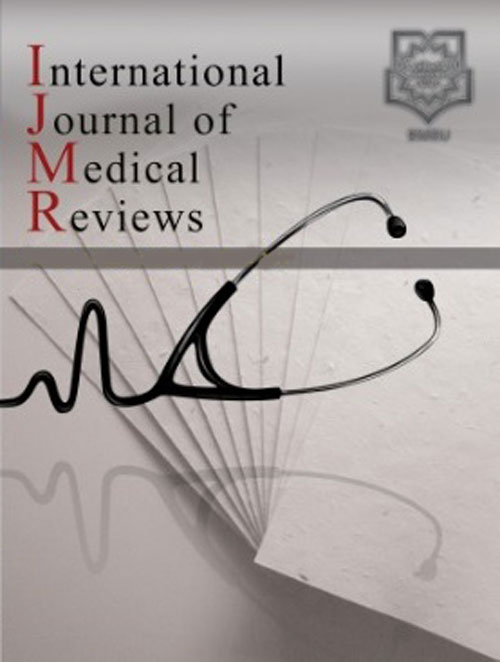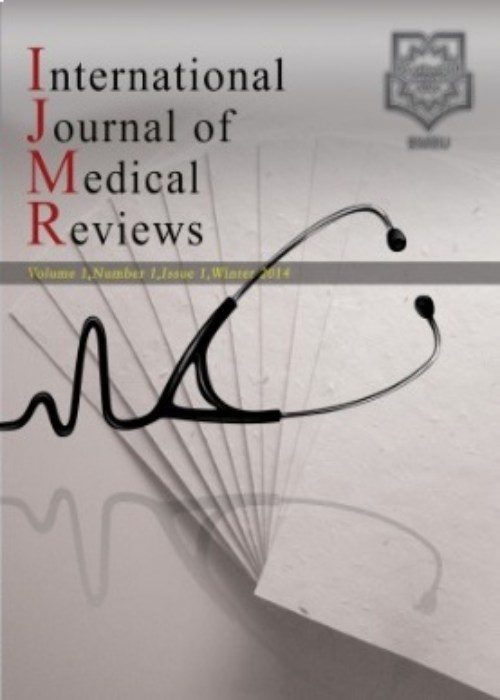فهرست مطالب

International Journal of Medical Reviews
Volume:2 Issue: 1, Winter 2015
- تاریخ انتشار: 1394/03/05
- تعداد عناوین: 7
-
Page 191IntroductionThe Adaptive Support Ventilation (ASV) mode is one of the most advanced ventilation modes. Examining the available scientific texts which analyze the various results of applying this mode, would improve the cardiac surgery patients’ conditions undergoing this mode. This study has been accomplished in order to recognize clinical experiences in using this mode in cardiac surgery patients. Design & setting: In this systematic review data banks such as PubMed, Science Direct, High Wire, Ovid and ProQuest and the Google Scholar searching motor were used. The chosen articles were limited to English language ones. Also the chosen articles were from 1994 to the end of 2013. The used key words were cardiac surgery, ASV, weaning, ICU and clinical experiences. Participants & Interventions: Based on the relation between the papers and the question of the study and the expert’s opinion of the research group, the related papers have been chosen and analyzed. Measurements and MainResultsAmong 105 papers which were found at the end of searching in the data banks, 8 completely related papers were chosen. The only variable that had commonly been considered in all of them was the patients’ disconnection time from the mechanical ventilator. The other four variables included intubation time, patients’ ICU and hospital stay, sedative requirements and numbers of ABGs.ConclusionsThe results indicate that ASV is a user friendly ventilation mode and can decrease both patients’ ICU & hospital stay and health care expenses due to the decreased intubation time. Related studies to this research are limited so this means more considerations in this background are suggested.Keywords: Adaptive Support Ventilation mode, cardiac surgery, clinical experiences
-
Page 197Erectile Dysfunction (ED) is a very important health issue that has a significant negative impact on the quality of life and life satisfaction of both the affected individual and his partner worldwide. Recently, advances in basic sciences have been instrumental in the evolution of the male sexual health treatment paradigm from a psychosexual model to a new model, which includes oral and intracavernosal injection pharmacotherapy, vacuum constriction devices, and penile prostheses for the treatment of ED. This progress has coincided with an increased understanding of the nature of male sexual health problems. Epidemiological data confirming these problems are widely prevalent and reveal the source of considerable morbidity, both for individuals and within relationships. In this research we have investigated the updated treatments and the recent studies about ED.Keywords: Erectile Dysfunction_Phosphodiesterase Type 5 Inhibitor_Psychosexual Therapy
-
Page 201IntroductionThe urban life and the problems of megalopolises have caused families to fail paying attention to the aging. According to the viewpoint from the experts in healthcare fields; the rising population of the aging in the country will expose the related social organizations and institutions with complex difficulties in an imminent outlook. The present study has dealt with this topic by means of the data derived from the project “Urban Health Equity Assessment and Response Tool (Urban HEART-2)” which has been implemented in the Municipality of Tehran in 2011. This study is an applied type and its data has been gathered by a cross-sectional technique. In order to collect information in 22 districts and 368 neighborhoods in Tehran, data were collected by using a multi-stage sampling technique. The total sample size included 1’117’845 people and statistical analyses were done on 15’030 old participants. Similarly, the needed data in this study in non- old group were examined in 102’355 people. Likewise, the related data to healthcare costs and the needed data for the calculation of catastrophic costs were extracted from both of old and non- old groups (<60 years). In this study, the mean healthcare costs of diseases was explored in both groups of the aging and the ones under the age of 60. The catastrophic healthcare costs were calculated for the two studied groups by means of the method confirmed by the World Health Organization (WHO).ResultsThe findings from this research show that the old age rate in Tehran is higher in compared tothis rate throughout the country. In a statistical survey conducted on healthcare cost index, a significant difference with a confidence interval (99%) was observed in two age groups under 60 years of age (non- old people) and over 60 years of age (aging). A review on hospitalization costs, diagnostic services cost, medical examination and transportation costs for medical services in both groups of the aging and those under the age of 60 indicated that a significant difference was seen at a confidence level of 99% while 12.9% of the families with old members might incur catastrophic healthcare costs. At the same time by exploring in catastrophic healthcare costs in both groups of the aging and those under the age of 60 a significant statisticaldifference was seen among both studied groups.ConclusionThe Iranian healthcare system is exposed to challenge the high- rising of such costs like other medical systems. The results of this study indicates that the healthcare costs and catastrophic healthcare expenses are at high level in the families with old members in Tehran. The rising catastrophic costs in the aging may be due to many reasons such as high percentages of personal payment and inadequate coverage by insurance. It seems that the supporting policies and the exemptions from the payment of healthcare costs should be employed to reduce the percentage of exposing the families to catastrophic healthcare costs for the aging as a specific population group.Keywords: Aging, Healthcare Costs, Catastrophic Healthcare Costs
-
Page 209IntroductionAll of us start elderly from our birth. This process doesn’t stop or reverse but we can postpone it by appropriate caring and minimizing habits which lead to faster elderly by using suitable methods.MethodologyIn this study researcher use systematic review method in a purposeful way and focusing on research question, so retrieving, evaluating and consolidating searched required information.FindingsThe results of analyzing the data of 13 selected papers in regards to the research question indicates that different methods exist for teaching self-care to patients. These methods are summarized in three categories: 1- teaching by nurses 2- prevocational interviews and 3- changing teaching methods from traditional to modern.ConclusionInforming and educating the traditional nursing education using new technologies (computers and internet), applications (video doctrine itself) and participating in educational and counseling programs are important for self-care education and changes in the behavior of the elderly.Keywords: Teaching, Learning, Elderly, Self, care
-
Page 214IntroductionDecision-making, one of the most important conscious processes, is a cognitive process which ends up in choosing an action between several alternatives. The present paper studies the theoretical literature with the aim of forming an integrated concept of decision-making.MethodsIn the present review, “Decision, Decision-making, types of decision-making, methods of decision-making, classification of decision-making, decision-making reinforcement, decision-making facilitation, decision-making reduction, decisionmaking deficiencies, decision-making optimization, decision-making assessment, and decision-making evaluation” were the keywords which were searched in “PubMed, ScienceDirect, Google Scholar, Google Patent, MagIran, Taylor and Francis, SID, Proquest, Ebsco, Springer, IEEE, Kolwer, & IranDoc” search engines. With respect to the relation of the study parts, academic publishes after 2000 and the relevant Jadad system sources were selected. The manuscripts then were finalized by the evaluation of five experts in decision-making studies via the Delphi method.Results9 definitions in 3 classes, 4 involved factors, 5 types of decision-making, processes and steps of decision-making, 11 techniques of individual and participatory decision- making, 3 groupings of steps of decision-making, 5 related theories, 7related constructs, MCDM, biopsychological bases, military decision-making, medical decision- making, and Islamic decision-making were found.ConclusionTeaching correct ways of decision-making, appending decision-making courses to syllabi of university majors, and the development of databases in varied domains, especially in medical services, are among the effective strategies to improve decision-making and reduce the costs of decision-making mistakes.Keywords: Decision, Decision, making, Decision, making methods, Jadad Method, Delphi Method
-
Page 227IntroductionToday, decision making in the management of large organizations is of paramount importance that some researchers have identified the knowledge of organizational management as decision net and management as decision-making. All experts are aware of the importance of decision-making.MethodsThis is a descriptive-analytic and cross-sectional research. The target group was the project, plan and budget deputy of the Baqiyatallah University of Medical Science. The Rational Rose software (2003 version) was used for analyzing and designing the system.ResultsIn general, essential infrastructures were prepared for setting up the system. And managers as main users of the system notified that the management information system is one of their most essential needs. Discussion andConclusionas there are necessary infrastructures for applying IT in the university, and determining the minimum standards based on the advancing methods and analyzing the organizational systems through the scientific methods, providing software that are able to exchange information with each other are needed.Keywords: Information Architecture, Management Information System, RUP, Data, Supervision


